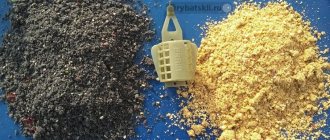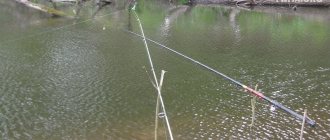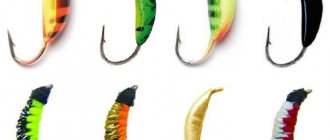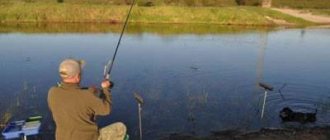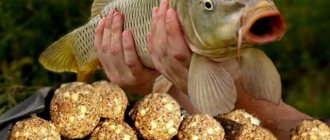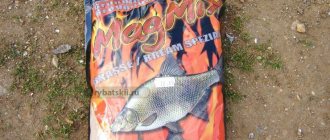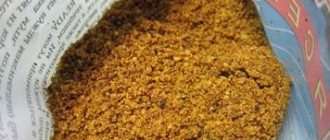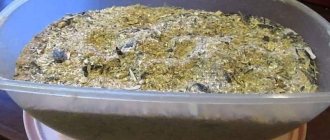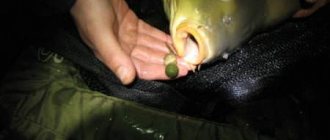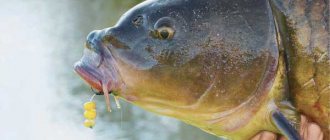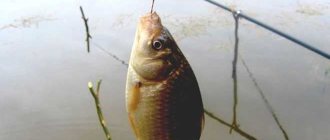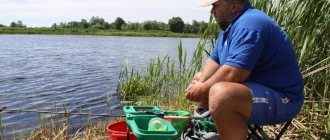Groundbait and its hydration. We prepare the bait correctly. Important nuances related to moistening the mixture and correct feeding of bait.
Preparing bait and correctly presenting it to the fish (especially on the river) is much more important for success than buying the coolest, most expensive mixture and relying only on its composition. This is an axiom of float and bottom fishing, and any of the most eminent fishermen in the world will subscribe to this statement, unless, of course, he is bound by strict obligations with the “sensas-trabuccas”, or he himself is not engaged in the production of his own bait.
Water in bait - good and evil
Water can be both good and evil - it can save you from mortal thirst, or it can take many thousands of human lives in one deadly wave in an instant. Water in bait can be good and evil. Moreover, the evil is so strong that complementary feeding will be of no more use than a brick lying at the bottom.
What to do with dry bait mixture before fishing?
It’s clear that it should be moistened with water. And everything seemed simple and clear: moistened it without adding too much water; mixed everything properly; let it brew a little - soak in; Yes, make your own bait balls or fill the feeder with food.
But is it really that simple with water in bait?
Let's try to look at the process more seriously, trying not to make mistakes and spoil the initially high-quality mixture. Wetting is a rather imprecise word to fully describe this important stage in the bait preparation process. And this is not just a play on words - you can wet it quickly and quickly start fishing. But you won’t be able to moisturize well quickly, and knowing this circumstance leads to good catches.
Feeder bait components
Firstly, you need to know that feeder bait consists of two parts:
- The basis of the composition.
- Various additives.
Millet cereal is used as the base. Many species of fish love it, especially bream. You can also use mixed feed or breadcrumbs as a basis.
The following components are used as additives:
- Pearl barley.
- Peas.
- Corn.
- Wheat supplement.
- Earthworms.
- Buckwheat.
- Oatmeal or cereal.
- Rice, barley and other cereal additives.
Flavorings are also added to the bait, for these purposes the following are used:
- Dry vanilla.
- Anise.
- In some cases honey.
The following video describes a recipe for catchable bait for white fish: crucian carp, bream, carp and roach.
Moistening bait with water
Typically, cold water is used to moisten the bait mixture, usually from the very reservoir in which fishing is planned. But cold water is quite insidious and only creates the illusion of quickly soaking all particles of bait. It’s good if the bait itself is homogeneous - say, it’s just breadcrumbs. But good bait for fish, especially large ones, is usually quite complex; in addition to the same crackers, there are various cakes and it is simply impossible to quickly and equally efficiently moisten all particles of the mixture. As a result, poorly moistened particles will tend to quickly replenish moisture, and will break away from the balls, float up and be carried away from the fishing zone by the current.
Some fishermen believe that it is enough to let the moistened bait mixture sit for 20 or even 10 minutes. But I am sure that when fishing in a current, especially a strong one, the bait must be moistened at least an hour before fishing, and even this consistency will not be able to firmly anchor itself on the river soil. The bait, which simply has to wait for the fish to approach, firmly clinging to the bottom already in a washed-out state, should be moistened with water 3-4 hours before the start of fishing. You can moisten the complementary food in 8-10 hours, but in this case the mixture, although perfectly saturated with water, can turn sour (especially when fishing in the hot summer), and this is no good. By the way, we cannot smell the beginning of the bait fermentation process with our human nose, but the fish instantly understands this and can ignore all our efforts.
The question immediately arises: what water is best for bait and where to get it?
After all, you shouldn’t come to a pond 4 hours in advance just to wet the bait? But there is water everywhere, and the most meticulous fishermen can moisten their bait with even the purest drinking bottle from a store-bought bottle, or even distilled water.
It is also important to speak out about the need to use clean water for bait. We regularly hear and read that the water flowing from our home taps is “death” for bait, as it contains chlorine. I once thought so too - bleach is not millet. But quite extensive experiments have convinced that water from a home tap is quite suitable for moistening bait, without in any way reducing the attractive properties for fish. Chlorine is, of course, present in our tap water, but in very small quantities. And the powerful range of taste and aromatic properties of the bait mixture completely absorbs the supply of bleach. But this is true, by the way. It never hurts to play it safe, and it’s easier to use the purest water, without any foreign odors, to moisten complementary foods.
Is it possible to speed up the process of moistening river bait?
You can, for this you only need warm (not hot) water, which will quickly saturate the entire mixture. How fast? At least five times faster, and after “simmering” for an hour, the complementary food will be ready to lie on the bottom of the river. Warm water also has another important advantage - it “cooks” many of the food ingredients, which is especially important for cakes, which in this case become more attractive to fish.
What does homemade bait consist of?
The bulk
The base takes up half or more of the total mass of the bait.
The basis of the bait is the edible part for the fish; in most cases, the following materials are used for the base:
- Bread crumbs;
- Breadcrumbs;
- Flour from various grains;
- Hemp seeds.
To make small crackers, it is advisable to use brown bread crumbs, since this type of bread has a richer aroma than white or rye. If you are making crackers from white bread, you need to fry it on the stove until golden brown.
Good to know! If several types of base are used when preparing bait, crackers take up 20% of the total bait. Crackers take up half the mass of the entire bait if they are the basis.
An effective technique when catching peaceful fish of the order of caps is the addition of milk cookies. This will give the bait an additional aroma and taste that this subspecies cannot resist.
Hemp seeds are an effective basis for feeding roach, bream or bream. Roasted and crushed seeds have a white tint; they are added ½ of the mass of crackers.
Ground cereals are used as a base for preparing bait. Each grain attracts a different type of fish. In finished complementary foods it takes up 2/4 of the weight of crackers.
Cereals made from corn, peas and pearl barley are used in steamed, fried and natural (raw) form. Corn is added when fishing for carp species (carp, crucian carp), peas attract bream and bream, pearl barley is loved by roach.
In addition to the base, you need to add rippers, which is especially important when fishing in standing waters. So that the porridge does not remain in the feeder of the tackle.
Rippers include:
- Coconut flakes;
- Cake;
- Cake;
- Bran.
Feed elements
The stern part of the complementary food is made up of exactly what the fish will feed on. This element of the porridge attracts and keeps fish in the fishing spot.
In the absence or inappropriate food supply, it loses interest and quickly moves away from the feeding area. The stern part should occupy 4/10 of the base.
To create the stern, the following elements are used:
- Canned or boiled corn;
- Whole boiled peas;
- Hercules or oatmeal flakes;
- Earthworm;
- Maggot;
- Bloodworm.
Based on this, we can conclude that it is advisable to use as a feed additive what we directly fish with and attach to hooks.
As a supplement to the food supply, they also use:
- Fish bone meal;
- Crushed sunflower seeds;
- Powdered milk;
- Chopped peanuts.
Flavors and Additives
This element of complementary food serves to attract aquatic inhabitants to taste. Aromatic elements, as well as elements of the base and food supply, in most cases attract a certain subspecies of fish.
It is worth considering that fishing in the winter often does not require, or even prohibits, the use of any aromatic elements, which can lead to a cessation of the bite in general. Fishing the rest of the time welcomes the use of flavors.
The following elements can be used as flavoring agents:
- Garlic;
- Anise and camphor oil;
- Valerian tincture;
- Cocoa or coffee;
- Greens (dill, coriander, parsley, basil, etc.);
- Branded flavors (strawberry, caramel, tutti-frutti, vanilla).
| Fish | Suitable aroma element |
| Universal fragrances | Branded aromas, cocoa, coffee. |
| crucian carp | Garlic, black currant leaves. |
| Carp | Vanilla, caramel, anise oil, dill. |
| Bream and white bream | Garlic, cinnamon, honey, basil, coriander. |
| Roach | Cinnamon, camphor oil. |
Other optional additives include:
- Dyes (cocoa, flour, food coloring)
- Flavoring additives (coffee, salt, fish bone meal);
- Nutritious (peanuts, dry cream or milk);
- Adhesive additives (starch, baby food).
Peculiarities of preparing groundbait for beavers
High-quality moistening of the bait mixture is important not only for floaters, but also for bottom worms. After all, the feeder is practically the same bait ball of the floater, there is almost no difference. And being washed out of the feeder, poorly moistened food particles will quickly be carried away by the current from the fishing area. Maybe this is not bad for starting casts - the fish will be more quickly drawn to our hook with a nozzle. But when the bite starts and dry particles of food are carried away with the current, this is bad, because the fish rushes about, instead of calmly feeding in the feeder area, picking up particles of bait and getting hooked.
Of course, you can visually check how food is washed out of the feeder in the coastal zone. But we must not forget that at the channel depths, where we often fish, the picture may be different - there the current is usually more powerful, and the food will be washed out faster and flows further in streams.
The ideal picture seems to be this: the food is washed out of the feeder within 3-5 minutes, the feeding path stretches 2-3 meters, maximum 5 m downstream, the bait on the hook is located somewhere along the near border of the strip. Well-moistened particles of complementary food, even small and light ones, are not carried far downstream; they cling to everything possible at the bottom, get stuck in sand dunes, various folds of the bottom, under stones, under grass and algae - and this is good. Poorly moistened ones rush along the bottom to God knows where, just like completely dry ones if we throw them on the surface of the water.
Millet
Millet is used for filling in the form of hard-cooked porridge or dough. The porridge is cut into cubes of approximately 1 square. cm and is used for catching Carp, Carp and Bream.
Crucian carp is best caught using millet dough balls. These are the simplest and most common plant baits among anglers. They are used when fishing with a Float Rod, Donka, Feeder, or Mormyshka.
It all depends on the preferences of the fishermen, on their personal experience. Using Plant baits not only saves money on the purchase of Animal baits, but also sometimes makes the bite very active.
After all, baits go well with bait of plant origin.
The best bait for crucian carp in summer
In summer, the bite of crucian carp becomes more capricious than in spring. At this time of year, crucian carp are more cautious and picky and are influenced by the weather. The preferences of this fish in summer depend not only on the time of year, but also on the reservoir. Most often, in summer you can achieve more frequent bites on plant baits, but not always. In some reservoirs, crucian carp may peck at red worms living in close proximity to the reservoir, since crucian carp eats only what is familiar to it.
Vegetable baits
There are many varieties of plant bait for fishing crucian carp. These include cereals (manna, pearl barley), peas, dough, and corn. Below we will consider several types of the most popular bait for catching crucian carp.
Mastyrka
Pea mastyrka (Mandula) is a porridge made from peas. This attachment is perfect for fishing in the summer.
Preparation of mastyrka:
- 500 g of peas are placed in a pan, filled with water so that it is 4 cm above the level of the peas.
- Add 1 tsp. soda and salt.
- Leave to swell for 4 hours.
- Place the peas on the fire and bring to a boil.
- Reduce heat and cook, stirring occasionally, for 1.5 hours.
- Turn off the heat and mash the peas.
- Add 250 g of semolina to the peas, mix, and let cool.
- Take out the resulting mass, add another 250 g of semolina and 1 tbsp. l. sunflower oil with flavor.
- Mix thoroughly.
A detailed article with visual examples of the steps of preparing and placing mastyrka on a hook.
The mass turns out to be quite sticky. Place small balls on the hook so that the tip of the hook is covered. Mastyrka gets wet in the water quite quickly and can often fly off the hook; this should be taken into account during the fishing process and the presence of a bait on the hook should be checked more often.
This bait can be stored for up to two months in the refrigerator. It can be stored in the freezer for up to six months.
Semolina chatter
This bait is very effective when catching crucian carp in the summer, and it is also very easy to prepare.
- You need to combine semolina and water in equal quantities and leave the mixture for an hour.
- After an hour, you need to mix the mixture again.
- The resulting mixture must be filled into a syringe.
It is very simple to insert the talker - the syringe is brought to the tip of the hook and slowly pressed. The resulting mass itself is distributed along the length of the hook.
The mash can be stored in the freezer for up to six months.
Bread
For planting, rye or wheat bread or loaf will do. To prepare the bait, roll out the bread to form a ball and add a few drops of vegetable oil.
The bread should be placed in small balls on a hook with a short shank.
This bait is good to use fresh.
Dough
Preparation of the dough:
- Pour boiling water into wheat flour and stir.
- Add semolina or crushed cookies.
- The mass must be thoroughly kneaded with your hands.
The dough falls off the hook very quickly. To avoid having to change the nozzle every 5 minutes, you should add crushed cotton wool to it.
After freezing, the dough becomes liquid, so you can store this bait in the refrigerator for up to 1 month, but it is best to use fresh dough.
Barley porridge
To prepare pearl barley bait, you need to fill it with water for 2 hours. The soaked cereal is boiled in salted water for about 40 minutes. The bait is ready when the first grain begins to pop. Then the water is drained, a little unrefined sunflower oil is added, and cooled.
The bait turns out to be quite dense and practically does not get wet in water, which allows it to stay well on the hook.
It is necessary to plant pearl barley by the dark core. This way the bait stays on the hook much longer.
You can store pearl barley in the refrigerator.
Below is a video with a recipe for preparing excellent bait for catching crucian carp:
